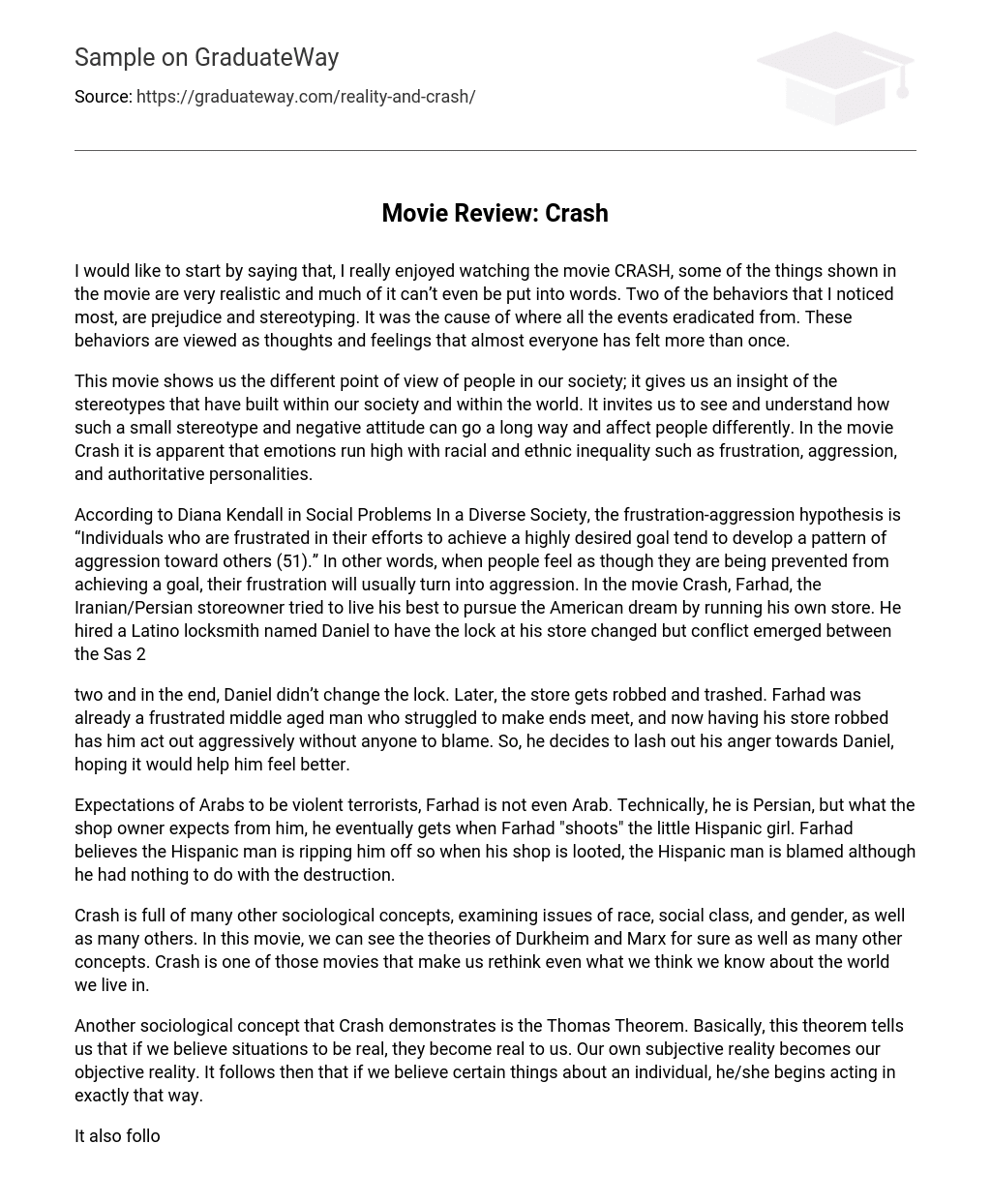Regarding the movie CRASH, I must express my enjoyment of it as it skillfully portrays realistic situations that are difficult to describe. The prevalence of prejudice and stereotyping in the film stood out to me, acting as the catalyst for all the ensuing events. These behaviors are relatable to nearly all individuals, often experienced as thoughts and emotions.
The movie Crash examines the various perspectives in our society and sheds light on the stereotypes that exist both within our society and globally. It challenges us to recognize the impact that even the smallest stereotype or negative attitude can have on individuals. Throughout the film, emotions related to racial and ethnic inequality, including frustration, aggression, and authoritative behavior, are prominently displayed.
According to Diana Kendall in Social Problems In a Diverse Society, the frustration-aggression hypothesis states that individuals who are unable to achieve a desired goal often become aggressive towards others (51). In the movie Crash, this hypothesis is exemplified through Farhad, an Iranian/Persian storeowner who is determined to achieve the American dream by running his own store. Farhad’s frustration leads him to hire Daniel, a Latino locksmith, to change the lock at his store. However, this decision ultimately leads to conflict (Sas 2).
Daniel never changed the lock, despite being reminded twice. Consequently, the store was later robbed and left in a state of disarray. Before this incident, Farhad, a middle-aged man already facing financial difficulties, felt frustrated with his circumstances. The robbery exacerbated his anger and lack of a scapegoat, leading him to vent his rage onto Daniel in the hope of finding some solace.
Contrary to the commonly held stereotype that associates Arabs with being violent terrorists, it should be noted that Farhad, the individual in question, is actually Persian. Nonetheless, the shop owner’s prejudiced expectations are fulfilled when Farhad tragically harmfully “shoots” a young Hispanic girl. Due to his belief that the Hispanic man is cheating him, Farhad unjustly accuses him for the looting that occurs at his store, despite the fact that the Hispanic individual is not involved in any way with the act of destruction.
The movie Crash delves into various sociological concepts, including race, social class, and gender, among others. Notably, the film portrays the theories of Durkheim and Marx alongside other concepts. In essence, Crash compels us to reconsider our preconceived notions about the world we inhabit.
Crash also explores the sociological concept of the Thomas Theorem, which suggests that our belief in the reality of a situation can make it real for us. Our subjective perception becomes our objective reality. This means that if we hold certain beliefs about someone, they are likely to act in accordance with those beliefs.
It can be concluded that some crimes or issues do not have an objective existence. Using drugs serves as an instance of a victimless crime. The movie exemplifies this concept when Jean Cabot clutches her purse while passing by Anthony (Luda cris) and Peter on the street. Due to her belief that black people are dangerous, her subjective perception becomes a reality shortly after.
Sas 3
The occurrence of black men carjacking them illustrates the theory of micro-aggression, as it reflects the characters’ beliefs about others. Microaggressions are subtle insults (verbal, nonverbal, and/or visual) that people of color often experience without awareness or intention. While these incidents may initially have minimal impact, their cumulative effects can be harmful.
In Crash, the film director is the character who best exemplifies this issue. People often subtly insult him by suggesting that he isn’t truly black or making comments about his language during the movie shoot. For instance, he advises the black character to speak in a more stereotypically “black” way. These comments, along with the powerlessness he feels when his wife is sexually assaulted, build up until he explodes and puts himself in danger. Throughout his life, he has faced these subtle forms of racism and eventually reaches a breaking point where he refuses to endure it any longer.
The portrayal of ethnocentrism in the movie Crash illustrates the inclination to judge other cultures using our own criteria, while also considering our own culture as superior. The film features a conflict between Graham and his Latina girlfriend, where he derogatorily refers to her as Mexican despite her not being from Mexico.
Asian Americans face frequent ridicule for their speech patterns, such as using “blaking” instead of “braking.” Instead of appreciating or embracing other cultures’ traits, they mock them and assert their own cultural superiority. This behavior reveals a lack of understanding and empathy towards others, stemming from ethnocentric views. Even Officer Ryan mocks Shaniqua, a name often associated with African American culture.
In summary, Crash is a movie that is rich with sociological concepts. There are many more concepts that could be analyzed simultaneously. However, when we find humor in the movie, it is important to examine the underlying sociological assumptions or concepts that prompt our laughter. Are we laughing at racist jokes due to our own ethnocentrism? Are we oblivious to the constant microaggressions endured by minority groups? Are we just as culpable as Jean Cabot in constructing our own truths? Do we hold preconceived notions about certain groups and inadvertently make them a reality? Crash prompts us to reflect on all of these aspects.





